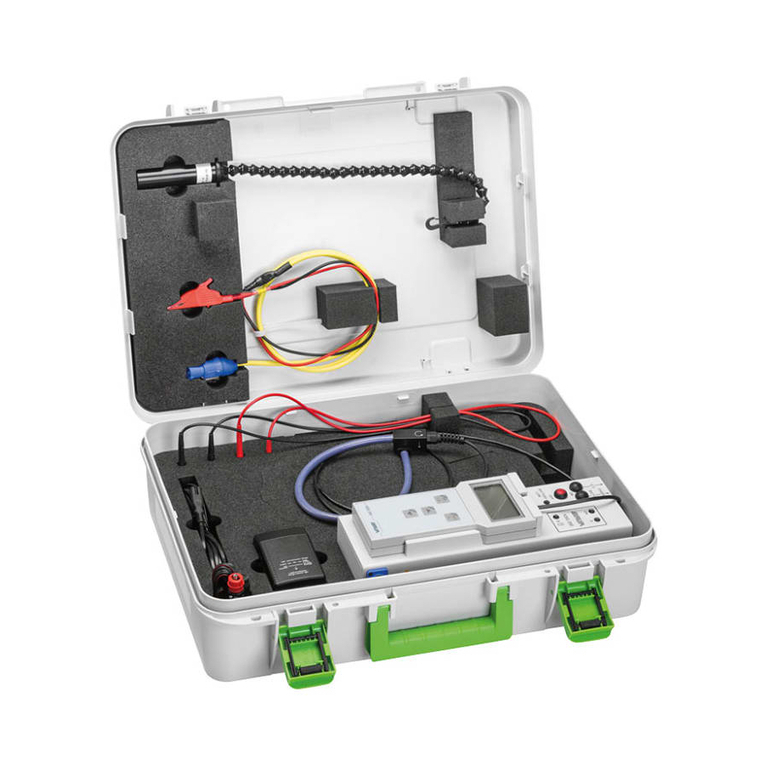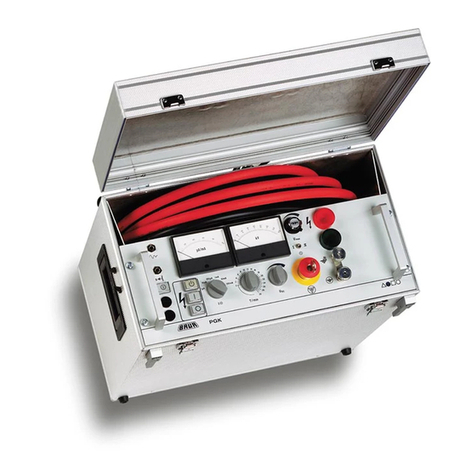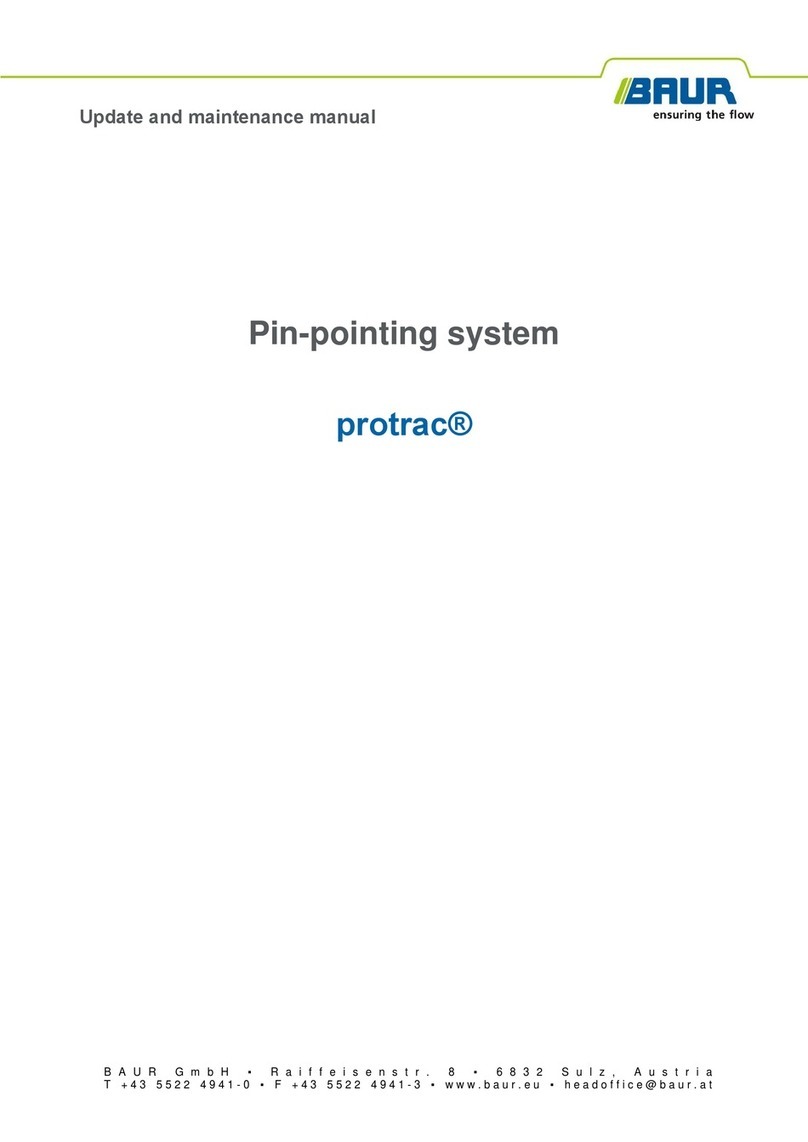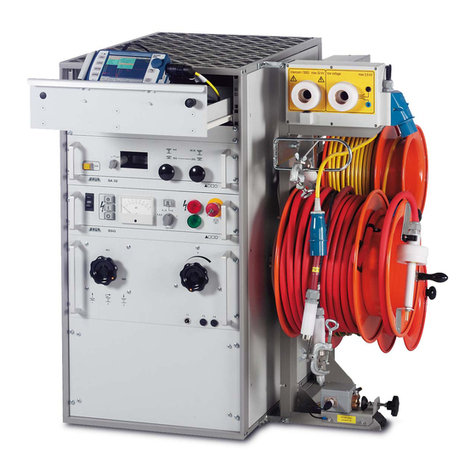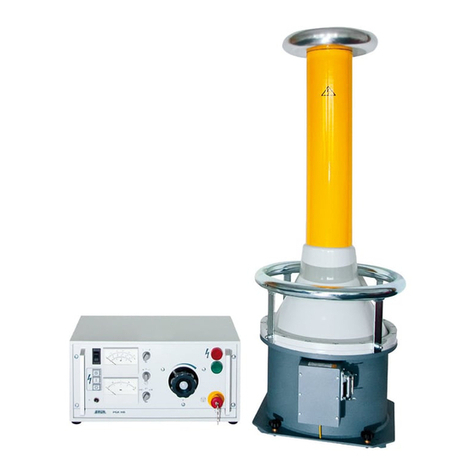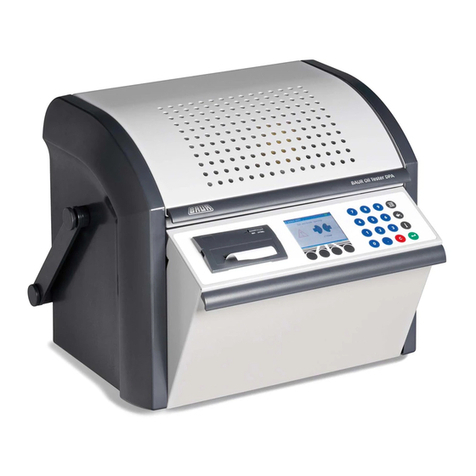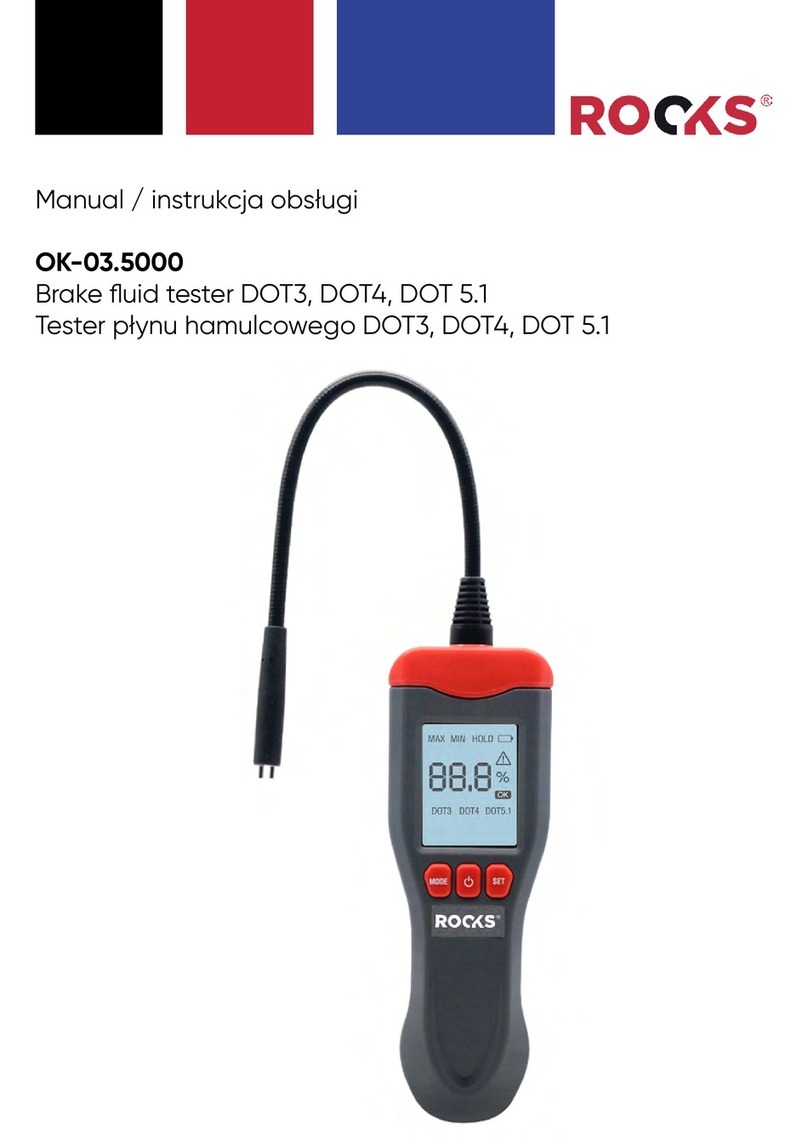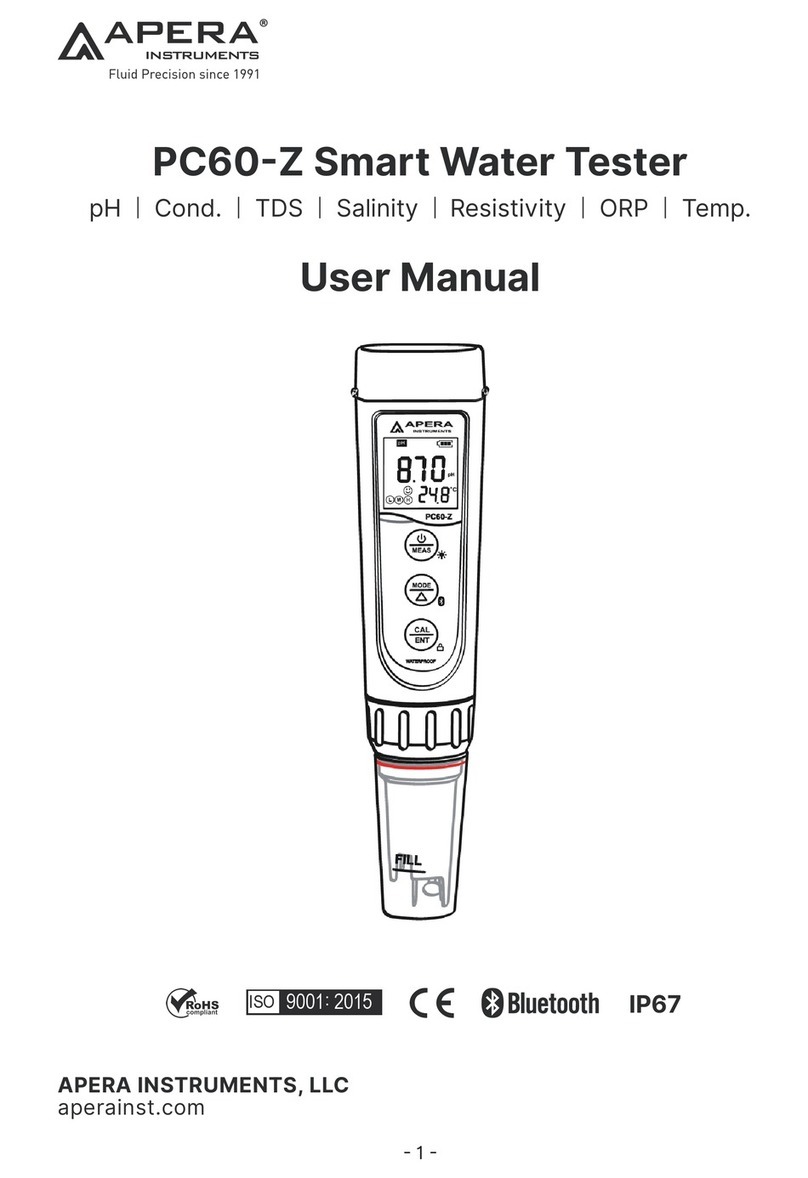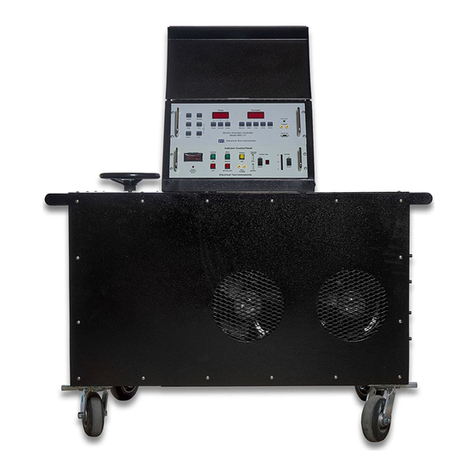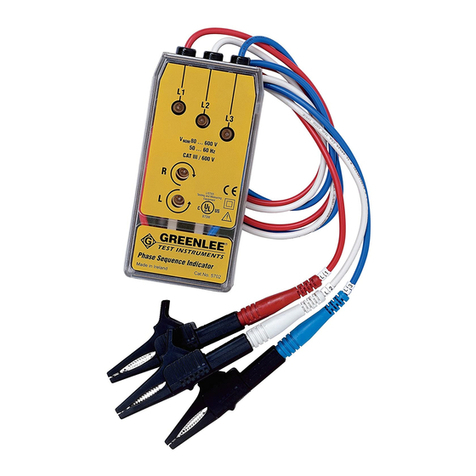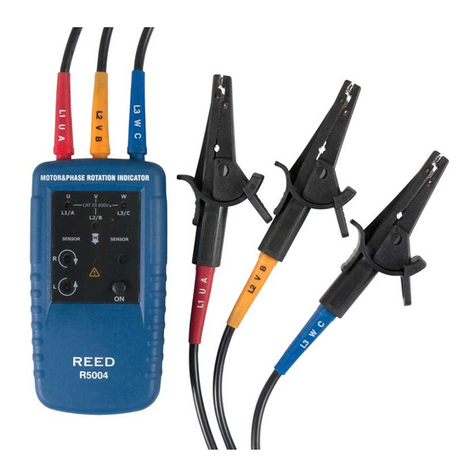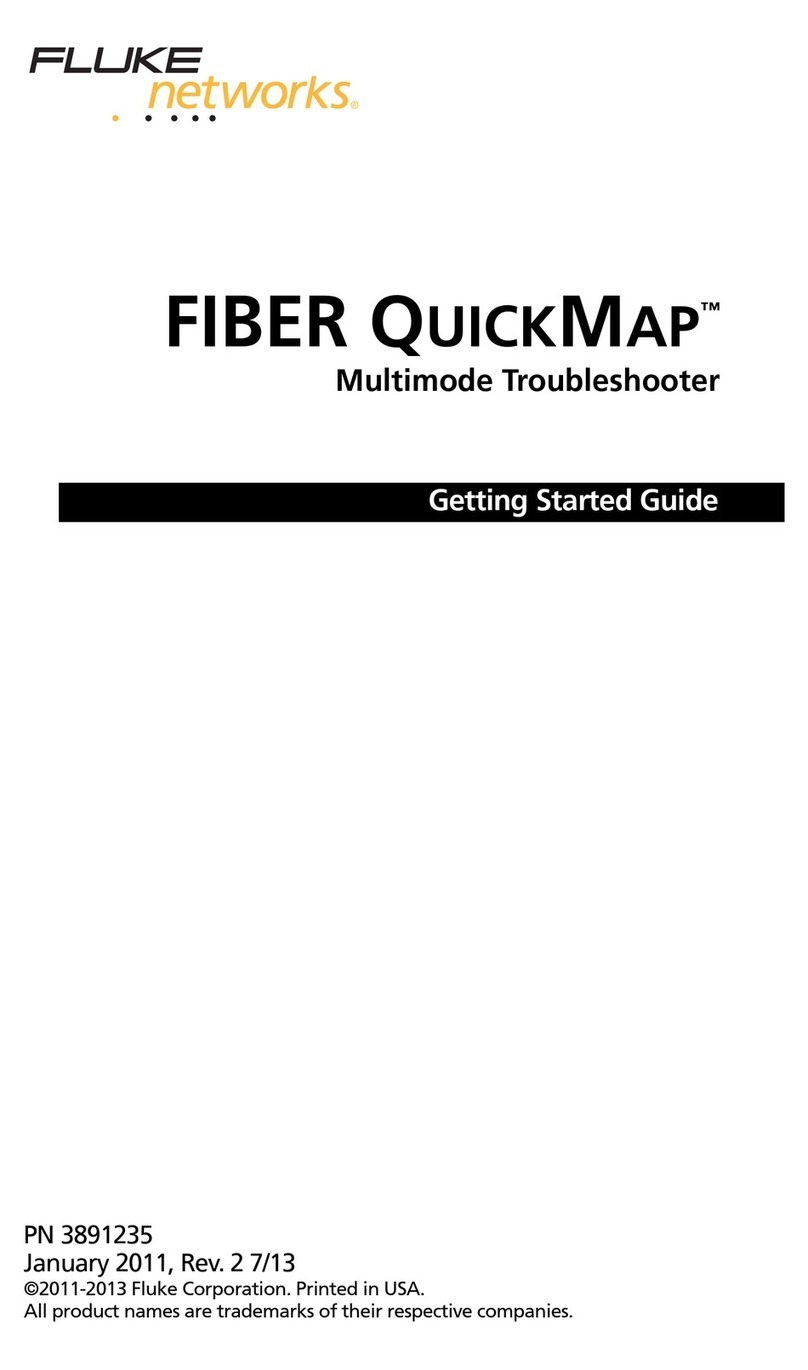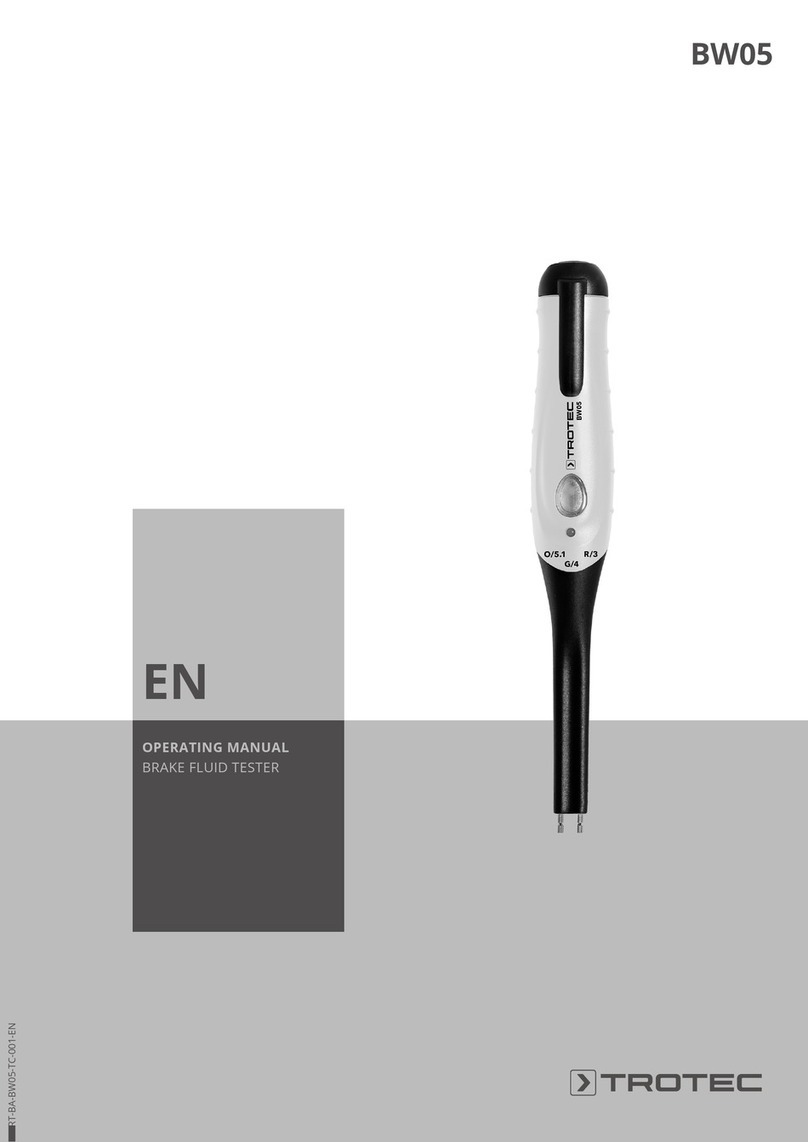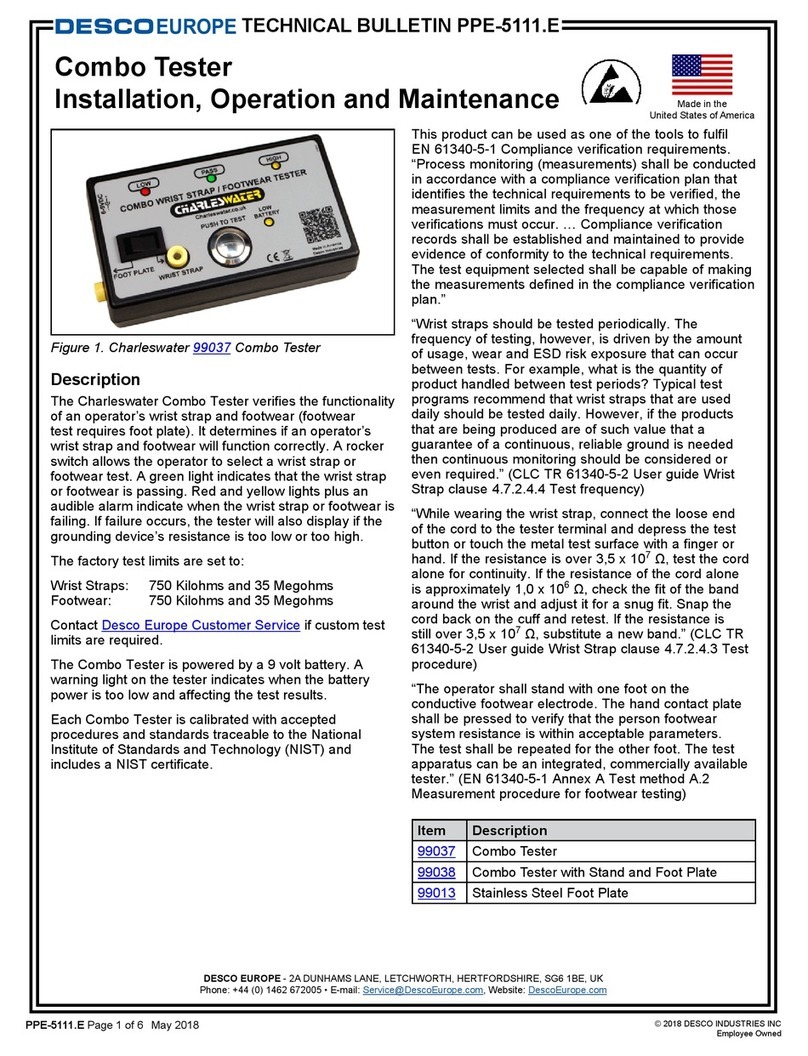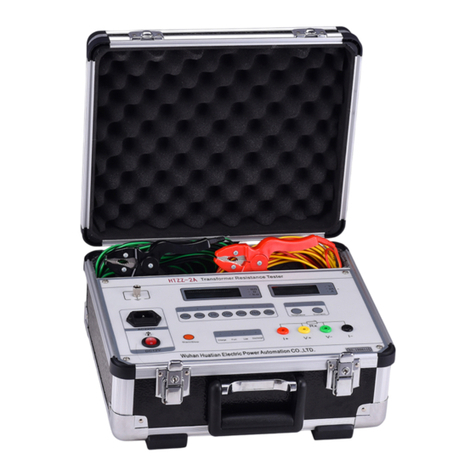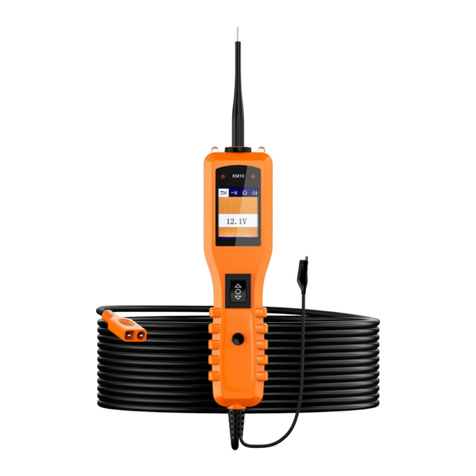Baur PGK 25 User manual

0-1
07/2002
Ident. no. 822-001
Operating Instructions
PGK 25
High Voltage Testing Set
BAUR Prüf- und Messtechnik GmbH
Raiffeisenstrasse 8, A-6832 Sulz / Austria Tel +43 / 55 22 / 49 41-0
Fax +43 / 55 22 / 49 4 13
e-mail: headoffice@baur.at
internet: http://www.baur.at

0-2

0-3
© BAUR Prüf- und Messtechnik GmbH,A-6832-Sulz / Austria
All rights reserved.
No part of this publication may be reproduced, transmitted, stored
in a data processing system or translated into another language
without the written permission of BAUR / Sulz,Austria.
In the interest of our customers we reserve the rights for
modifications due to technical progress.
Illustrations, descriptions and delivery content are therefore not
binding.
For fast finding of important information the corresponding text
passages are marked with symbols (symbols not stated here are
self-explaining):
More and special information concerning the respective subject are
available from BAUR.
Important unit information!
In any case, read carefully!
Important information text.
Observe info signs!
☞
Guide to this Operating Instruction
Copyright
© Copyright by BAUR
Subject to modification!
This manual contains all information necessary for the correct
handling and use of the PGK 25 High Voltage Testing Set. Before
using the PGK 25, please read carefully this Operating Instruction.
If you have any question, please contact directly:
Preface
BAUR Prüf- und Messtechnik GmbH, Raiffeisenstrasse 8
A-6832 Sulz /Austria
or refer to your nearest BAUR representative.
Phone +43 / 55 22 / 49 41-0
Fax +43 / 55 22 / 49 41 3
Safety Precautions
Please read now
and avoid damage
and injury later!
- The PGK 25 High Voltage Testing Set is built in accordance
with today’s state of engineering and is safe to operate.
Individual components and the finished unit are inspected
continually by our qualified staff within the framework of our
QualityAssurance Provisions. Each unit is subjected to
thorough testing prior to shipment.
Guide to this Operating Instruction, Copyright, Preface, Safety Precautions
Continued

0-4
- It is imperative to every person who is involved with the
installation, start-up, operation and maintenance to have read
and understood the complete Operating Instructions.
- It is the responsibility of the customer to ensure that only
authorized persons may be allowed to use the PGK 25.
- The user
•is qualified and properly instructed and has the necessary
experience.
•knows the relevant standards, accident prevention rules and
operatingconditions.
•is able to carry out the necessary operations and is aware of
the possible dangers involved.
•must immediately inform his superior about any conditions of
the unit that could affect safety.
The PGK 25 is a High Voltage Testing Set for insulation testing of
cables, windings and insulators.
The local safety and accident prevention regulations are
always applicable to the operation of the PGK 25.
Only authorized personnel!
Use the PGK 25 as directed!
Safety Precautions, Warranty
Safety Precautions, Continued
At the customer’s written request we undertake to repair or replace
at our discretion and as quickly as possible all parts that become
faulty or useless as the demonstrable result of poor material, faulty
design or defective execution.
The 12 month warranty time starts with delivery.
We shall bear the costs of any faulty parts requiring replacement,
but not the costs of transport to us and back to the customer, nor the
costs of packing and insurance! We shall not be liable for any
damage resulting from normal wear and tear, improper handling,
non-observance of Operating Instructions and safety regulations.
We shall also refuse to accept any liability if the customer carries out
repairs or changes to the unit himself or has others carry out them!
The warranty does not cover damage in transit, batteries, fuses and
any readjustments in accordance with the Operating Instructions!
We draw attention in addition to the ‘General Terms of Sales and
Delivery’ of:
Warranty
12 month warranty time
BAUR Prüf- und Messtechnik GmbH, Raiffeisenstrasse 8
A-6832-Sulz /Austria
☞

0-5
Contents
1. Operating Elements .........................................................................1-1
2. Packing and Shipping......................................................................2-1
Damage during transport ............................................................ 2-1
3. Power supply / Power selection .....................................................3-1
Maintenance ............................................................................... 3-1
General rule ................................................................................ 3-1
4. Setting into operation ......................................................................4-1
Plotter connector......................................................................... 4-2
5. Guard Connection............................................................................5-1
General....................................................................................... 5-1
Current measuring device........................................................... 5-2
Application .................................................................................. 5-3
6. Technical Data ..................................................................................6-1
General....................................................................................... 6-1
Mechanical Data ......................................................................... 6-2
Standard accessories ................................................................. 6-2
Special accessories .................................................................... 6-2
7. Insulation resistance chart..............................................................7-1
Contents

0-6
○○○ ○○○○○○○○○○○○○○○○○○○○○○○○○○○○○○○○○○○
○○○○○○○○○○○○○○○○○○○○○○○○○○○○○○○○○○○○○○
○○○ ○○○○○○○○○○○○○○○○○○○○○○○○○○○○○○○○○○○
○○○ ○○○○○○○○○○○○○○○○○○○○○○○○○○○○○○○○○○○
○○○ ○○○○○○○○○○○○○○○○○○○○○○○○○○○○○○○○○○○
○○○○○○○○○○○○○○○○○○○○○○○○○○○○○○○○○○○○○○
○○○ ○○○○○○○○○○○○○○○○○○○○○○○○○○○○○○○○○○○
○○○ ○○○○○○○○○○○○○○○○○○○○○○○○○○○○○○○○○○○
○○○○○○○○○○○○○○○○○○○○○○○○○○○○○○○○○○○○○○
○○○ ○○○○○○○○○○○○○○○○○○○○○○○○○○○○○○○○○○○
○○○○○○○○○○○○○○○○○○○○○○○○○○○○○○○○○○○○○○
○○○○○○○○○○○○○○○○○○○○○○○○○○○○○○○○○○○○○○
○○○○○○○○○○○○○○○○○○○○○○○○○○○○○○○○○○○○○○
○○○ ○○○○○○○○○○○○○○○○○○○○○○○○○○○○○○○○○○○
○○○○○○○○○○○○○○○○○○○○○○○○○○○○○○○○○○○○○○
○○○○○○○○○○○○○○○○○○○○○○○○○○○○○○○○○○○○○○
○○○ ○○○○○○○○○○○○○○○○○○○○○○○○○○○○○○○○○○○
○○○○○○○○○○○○○○○○○○○○○○○○○○○○○○○○○○○○○○
○○○ ○○○○○○○○○○○○○○○○○○○○○○○○○○○○○○○○○○○
○○○○○○○○○○○○○○○○○○○○○○○○○○○○○○○○○○○○○○
○○○○○○○○○○○○○○○○○○○○○○○○○○○○○○○○○○○○○○
○○○○○○○○○○○○○○○○○○○○○○○○○○○○○○○○○○○○○○
○○○ ○○○○○○○○○○○○○○○○○○○○○○○○○○○○○○○○○○○
Notes

1-1
1. Operating Elements
1. Operating Elements
12 3 4 514156
7
8
13 12 11 10 9
1 Push-button switch for battery test
2 Selector switch 0 - 5 kV or 0 - 25 kV
3 Voltage regulator with 0-locking
4 Range selector switch for current indication
5 Operating switch with timer and discharge unit
6 High voltage output with controlling contact
7 Connector for protective earth cable
8 Mains connector with power selector and fuses
9 Connectors for external battery (12 V)
10 Connector for current range plotter
11 H.V. control lamp
12 µA - meter
13 kV - meter with indication for battery test
Option: Guard connection
14 Operating mode switch for current measurement
15 Terminal for current measurement

1-2
1. Operating Elements
1-2
○○○○○○○○○○○○○○○○○○○○○○○○○○○○○○○○○○○○○○
○○○ ○○○○○○○○○○○○○○○○○○○○○○○○○○○○○○○○○○○
○○○○○○○○○○○○○○○○○○○○○○○○○○○○○○○○○○○○○○
○○○○○○○○○○○○○○○○○○○○○○○○○○○○○○○○○○○○○○
○○○○○○○○○○○○○○○○○○○○○○○○○○○○○○○○○○○○○○
○○○ ○○○○○○○○○○○○○○○○○○○○○○○○○○○○○○○○○○○
○○○○○○○○○○○○○○○○○○○○○○○○○○○○○○○○○○○○○○
○○○○○○○○○○○○○○○○○○○○○○○○○○○○○○○○○○○○○○
○○○ ○○○○○○○○○○○○○○○○○○○○○○○○○○○○○○○○○○○
○○○○○○○○○○○○○○○○○○○○○○○○○○○○○○○○○○○○○○
○○○ ○○○○○○○○○○○○○○○○○○○○○○○○○○○○○○○○○○○
○○○ ○○○○○○○○○○○○○○○○○○○○○○○○○○○○○○○○○○○
○○○ ○○○○○○○○○○○○○○○○○○○○○○○○○○○○○○○○○○○
○○○○○○○○○○○○○○○○○○○○○○○○○○○○○○○○○○○○○○
○○○ ○○○○○○○○○○○○○○○○○○○○○○○○○○○○○○○○○○○
○○○ ○○○○○○○○○○○○○○○○○○○○○○○○○○○○○○○○○○○
○○○○○○○○○○○○○○○○○○○○○○○○○○○○○○○○○○○○○○
○○○ ○○○○○○○○○○○○○○○○○○○○○○○○○○○○○○○○○○○
○○○○○○○○○○○○○○○○○○○○○○○○○○○○○○○○○○○○○○
○○○ ○○○○○○○○○○○○○○○○○○○○○○○○○○○○○○○○○○○
○○○ ○○○○○○○○○○○○○○○○○○○○○○○○○○○○○○○○○○○
○○○ ○○○○○○○○○○○○○○○○○○○○○○○○○○○○○○○○○○○
○○○○○○○○○○○○○○○○○○○○○○○○○○○○○○○○○○○○○○
Notes

2. Packing and Shipping
Complaints concerning damage should be made to us without
delay, using a standard damage claims form.
Confirmation of visible damage should immediately be obtained
from the carrier. The extent and probable cause of the damage
should be stated.
If damage is discovered during unpacking, contact the responsible
transportation company immediately. Request a written loss
assessment and make them responsible for the damage.
We also refer to the ’General Terms of Sales and Delivery’ of:
The Test Set is shipped in robust cardboard cartons. If Test Set is
not used immediately, store in carton in dry rooms!
2. Packing and Shipping
BAUR Prüf- und Messtechnik GmbH, A-6832 Sulz / Austria
Damage during transport
2-1

2. Packing and Shipping
○○○ ○○○○○○○○○○○○○○○○○○○○○○○○○○○○○○○○○○○
○○○○○○○○○○○○○○○○○○○○○○○○○○○○○○○○○○○○○○
○○○ ○○○○○○○○○○○○○○○○○○○○○○○○○○○○○○○○○○○
○○○ ○○○○○○○○○○○○○○○○○○○○○○○○○○○○○○○○○○○
○○○ ○○○○○○○○○○○○○○○○○○○○○○○○○○○○○○○○○○○
○○○○○○○○○○○○○○○○○○○○○○○○○○○○○○○○○○○○○○
○○○ ○○○○○○○○○○○○○○○○○○○○○○○○○○○○○○○○○○○
○○○ ○○○○○○○○○○○○○○○○○○○○○○○○○○○○○○○○○○○
○○○○○○○○○○○○○○○○○○○○○○○○○○○○○○○○○○○○○○
○○○ ○○○○○○○○○○○○○○○○○○○○○○○○○○○○○○○○○○○
○○○○○○○○○○○○○○○○○○○○○○○○○○○○○○○○○○○○○○
○○○○○○○○○○○○○○○○○○○○○○○○○○○○○○○○○○○○○○
○○○○○○○○○○○○○○○○○○○○○○○○○○○○○○○○○○○○○○
○○○ ○○○○○○○○○○○○○○○○○○○○○○○○○○○○○○○○○○○
○○○○○○○○○○○○○○○○○○○○○○○○○○○○○○○○○○○○○○
○○○○○○○○○○○○○○○○○○○○○○○○○○○○○○○○○○○○○○
○○○ ○○○○○○○○○○○○○○○○○○○○○○○○○○○○○○○○○○○
○○○○○○○○○○○○○○○○○○○○○○○○○○○○○○○○○○○○○○
○○○ ○○○○○○○○○○○○○○○○○○○○○○○○○○○○○○○○○○○
○○○○○○○○○○○○○○○○○○○○○○○○○○○○○○○○○○○○○○
○○○○○○○○○○○○○○○○○○○○○○○○○○○○○○○○○○○○○○
○○○○○○○○○○○○○○○○○○○○○○○○○○○○○○○○○○○○○○
○○○ ○○○○○○○○○○○○○○○○○○○○○○○○○○○○○○○○○○○
Notes
2-2

3. Power supply / Power selection
3-1
3. Power supply / Power selection
The unit is factory-set to 220 -230 V. If the unit is operated under
different power, remove power cord and open cover of voltage
selector using a small screwdriver. Now the voltage selector drum
can be withdrawn and inserted again after selecting.
Check also the inserted fuses and the amperage as shown on the
typeplate. Close cover by simply pressing on it.
Battery operation should only be performed with fully charged
battery.
Units with built in battery must be maintained. Since batteries
discharge even when instrument is not in use, batteries must be
recharged occassionally.
Charge batteries after approx.30 days as well as before instrument
is put into operation.
Discharged Dryfit batteries should not be put in storage.
☞
General rule
Maintenance

3. Power supply / Power selection
3-2
Notes
○○○○○○○○○○○○○○○○○○○○○○○○○○○○○○○○○○○○○○
○○○ ○○○○○○○○○○○○○○○○○○○○○○○○○○○○○○○○○○○
○○○○○○○○○○○○○○○○○○○○○○○○○○○○○○○○○○○○○○
○○○○○○○○○○○○○○○○○○○○○○○○○○○○○○○○○○○○○○
○○○○○○○○○○○○○○○○○○○○○○○○○○○○○○○○○○○○○○
○○○ ○○○○○○○○○○○○○○○○○○○○○○○○○○○○○○○○○○○
○○○○○○○○○○○○○○○○○○○○○○○○○○○○○○○○○○○○○○
○○○○○○○○○○○○○○○○○○○○○○○○○○○○○○○○○○○○○○
○○○ ○○○○○○○○○○○○○○○○○○○○○○○○○○○○○○○○○○○
○○○○○○○○○○○○○○○○○○○○○○○○○○○○○○○○○○○○○○
○○○ ○○○○○○○○○○○○○○○○○○○○○○○○○○○○○○○○○○○
○○○ ○○○○○○○○○○○○○○○○○○○○○○○○○○○○○○○○○○○
○○○ ○○○○○○○○○○○○○○○○○○○○○○○○○○○○○○○○○○○
○○○○○○○○○○○○○○○○○○○○○○○○○○○○○○○○○○○○○○
○○○ ○○○○○○○○○○○○○○○○○○○○○○○○○○○○○○○○○○○
○○○ ○○○○○○○○○○○○○○○○○○○○○○○○○○○○○○○○○○○
○○○○○○○○○○○○○○○○○○○○○○○○○○○○○○○○○○○○○○
○○○ ○○○○○○○○○○○○○○○○○○○○○○○○○○○○○○○○○○○
○○○○○○○○○○○○○○○○○○○○○○○○○○○○○○○○○○○○○○
○○○ ○○○○○○○○○○○○○○○○○○○○○○○○○○○○○○○○○○○
○○○ ○○○○○○○○○○○○○○○○○○○○○○○○○○○○○○○○○○○
○○○ ○○○○○○○○○○○○○○○○○○○○○○○○○○○○○○○○○○○
○○○○○○○○○○○○○○○○○○○○○○○○○○○○○○○○○○○○○○

4. Setting into operation
4-1
4.1 Setting into operation
The PGK 25 is designed in such a way, that no output current
is generated which could be harmful in case of body contact.
In the process of testing capacitive type test objects however,
dangerous charges may occur. In tests where charges of 350
mJ or higher are stored in items with which persons could
make contact, special protection measures are required to
avoid direct or indirect contact with live parts.
1) Connect instrument with protective earth lead (461-308) via
protective earth connector (7) with station earth.
2) Connect instrument and test object with H.V. cable (460-437).
3) Mains operation:
Connect instrument with power cord (554-005). Please pay
attention to selected mains voltage!
Battery operation:
Check battery voltage by pressing push-button switch (1).The
state of charge of the battery will be indicated by the kV meter.
In battery test, the needle must be within the marked range.
4) Set range selector switch (2) to the desired range (0-5 kV or
0-25 kV).
5) Set voltage regulator (3) to "0".
(Otherwise the instrument cannot be turned on).
6) Set range selector switch (4) of amperemeter to maximum
value (10 mA).
7) The high voltage will be turned on by the timer (5) and the
control lamp (11) will be on.
8) Now the high voltage can be set to the desired value by turning
the voltage regulator (3). The current range selector switch (4)
can also be adjusted.
9) Only now the timer (5) should be set to the desired operating
time. The insulation resistance of the test object, resulting from
current and voltage can now be determined by using the
attached chart.
10) Instrument shutdown; turn timer (5) completely counter-
clockwise; H.V. control lamp (11) will be off.
11) Once the H.V. lamp is off, the integrated discharge unit will
automatically be activated. The connected test objects
(capacities) will be discharged slowly via a resistor (125 k
Ohms). The discharge time at 6 µF is approximately 5
seconds.
Before touching the test object short-circuit test object and
connect it to earth!
☞

4. Setting into operation
4-2
It is possible to plot the test current as function of time to a
external plotter via the plotter connector (10) of the PGK 25. The
output voltage is function of the current range (4) 200mV at full-
scale deflection of the internal ampermeter
4.2 Plotter connector

5. Guard Connection
5-1
5. Guard Connection
Starting with series 16 of the PGK 25, a Guard connection is
provided as an option. With the feature, a variety of measurements
jobs can be performed where the connections for the shield and
current measuring terminal are separately mounted.
In the Guard option, resistors with 1 kΩΩ
ΩΩ
Ω/ 200W are integrated
in the current measuring lead (461-408) and in the shield
connection of the H.V. lead. These resistors serve for the
protection of the instrument against transient voltages.
The resistors in the connection leads must be checked for
damage after high voltage breakdown of test objects with high
capacity (> 0.5 µF) or heavy mechanical stress.
H.V. connection
General

5. Guard Connection
5-2
Current measuring device
The current measuring device of the PGK 25 has 5 measuring
ranges from 1 µA to 10 mA. Due to the separately mounted
connectors for shield and current measuring terminal M, spurious
currents can be excluded from measurements.
With the operating mode switch (14) in position ''A'', the current
measuring terminal (15) is connected to earth. The current
measuring device acquires all currents which flow from the H.V.
output to earth. Internal insulation currents as well as corona
currents from test configuration are also acquired by the current
measurement. Through the shield connection, partial currents (e.g.
surface currents on insulators) can be returned to the high voltage
source, without being acquired by the current measuring device. If
the shield connection is not used it must be isolated from earth,
otherwise the µA-meter will be short-circuited.
With the operating mode switch (14) in position ''B'', the current
measuring terminal (15) is electrically isolated. The current
measuring device acquires all currents which are conducted
through the current measuring terminal (15). The insulation currents
and corona currents which flow from the instrument or the test
configuration to earth, will not be acquired by the current measuring
device. The shield connection may be connected to earth. The test
object must be configured in such a way, that it is insulate from
earth.
The test lead may not be interrupted during testing, otherwise
the test lead could carry high voltage!
Operating mode A:
(test object connected to earth)
Operating mode B:
(test object not
connected to earth)
Shield

5. Guard Connection
5-3
Application
Insulation test between a conductor and the shield.
The insulation currents between the conductors will be ignored.
Shield of test object
connected to earth
Guard
Station earth

5. Guard Connection
5-4
The test lead may not be interrupted during testing, otherwise
the test lead could carry high voltage!
Insulation test between the conductors. The insulation currents
between the conductors and the shield will be ignored.
☞
Insulation test between conductor and shield.All of the insulation
currents will be measured.
Conductors of test object not
connected to earth
Conductors of test
object and shield
connected to earth
Station earth
Guard
Guard
Station earth

5. Guard Connection
5-5
☞
Insulation test of a H.V. insulator. Under this test, the surface
currents of the insulator will be ignored.
Measurement of surface currents. Insulation leakage currents
which are flowing to the housing will be ignored during this test.
Very small surface currents can be measured.
The test lead may not be interrupted during testing, otherwise
the test lead could carry high voltage!
Housing
Contact ring
Insulator
Station earth
Guard
Housing
Contact ring
Insulator
Station earth
Guard

5. Guard Connection
5-6
○○○ ○○○○○○○○○○○○○○○○○○○○○○○○○○○○○○○○○○○
○○○○○○○○○○○○○○○○○○○○○○○○○○○○○○○○○○○○○○
○○○ ○○○○○○○○○○○○○○○○○○○○○○○○○○○○○○○○○○○
○○○ ○○○○○○○○○○○○○○○○○○○○○○○○○○○○○○○○○○○
○○○ ○○○○○○○○○○○○○○○○○○○○○○○○○○○○○○○○○○○
○○○○○○○○○○○○○○○○○○○○○○○○○○○○○○○○○○○○○○
○○○ ○○○○○○○○○○○○○○○○○○○○○○○○○○○○○○○○○○○
○○○ ○○○○○○○○○○○○○○○○○○○○○○○○○○○○○○○○○○○
○○○○○○○○○○○○○○○○○○○○○○○○○○○○○○○○○○○○○○
○○○ ○○○○○○○○○○○○○○○○○○○○○○○○○○○○○○○○○○○
○○○○○○○○○○○○○○○○○○○○○○○○○○○○○○○○○○○○○○
○○○○○○○○○○○○○○○○○○○○○○○○○○○○○○○○○○○○○○
○○○○○○○○○○○○○○○○○○○○○○○○○○○○○○○○○○○○○○
○○○ ○○○○○○○○○○○○○○○○○○○○○○○○○○○○○○○○○○○
○○○○○○○○○○○○○○○○○○○○○○○○○○○○○○○○○○○○○○
○○○○○○○○○○○○○○○○○○○○○○○○○○○○○○○○○○○○○○
○○○ ○○○○○○○○○○○○○○○○○○○○○○○○○○○○○○○○○○○
○○○○○○○○○○○○○○○○○○○○○○○○○○○○○○○○○○○○○○
○○○ ○○○○○○○○○○○○○○○○○○○○○○○○○○○○○○○○○○○
○○○○○○○○○○○○○○○○○○○○○○○○○○○○○○○○○○○○○○
○○○○○○○○○○○○○○○○○○○○○○○○○○○○○○○○○○○○○○
○○○○○○○○○○○○○○○○○○○○○○○○○○○○○○○○○○○○○○
○○○ ○○○○○○○○○○○○○○○○○○○○○○○○○○○○○○○○○○○
Notes
Table of contents
Other Baur Test Equipment manuals
Popular Test Equipment manuals by other brands

AFL
AFL OLS1 user guide

TAKAYA
TAKAYA APT-9411 Series Operator's manual

Chauvin Arnoux
Chauvin Arnoux PAC 12 user manual

Bacharach
Bacharach Florite 800 Installation, operation & maintenance manual
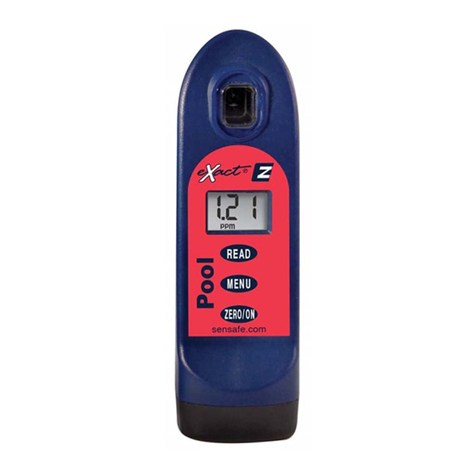
Industrial Test Systems
Industrial Test Systems Pool eXact EZ quick start guide
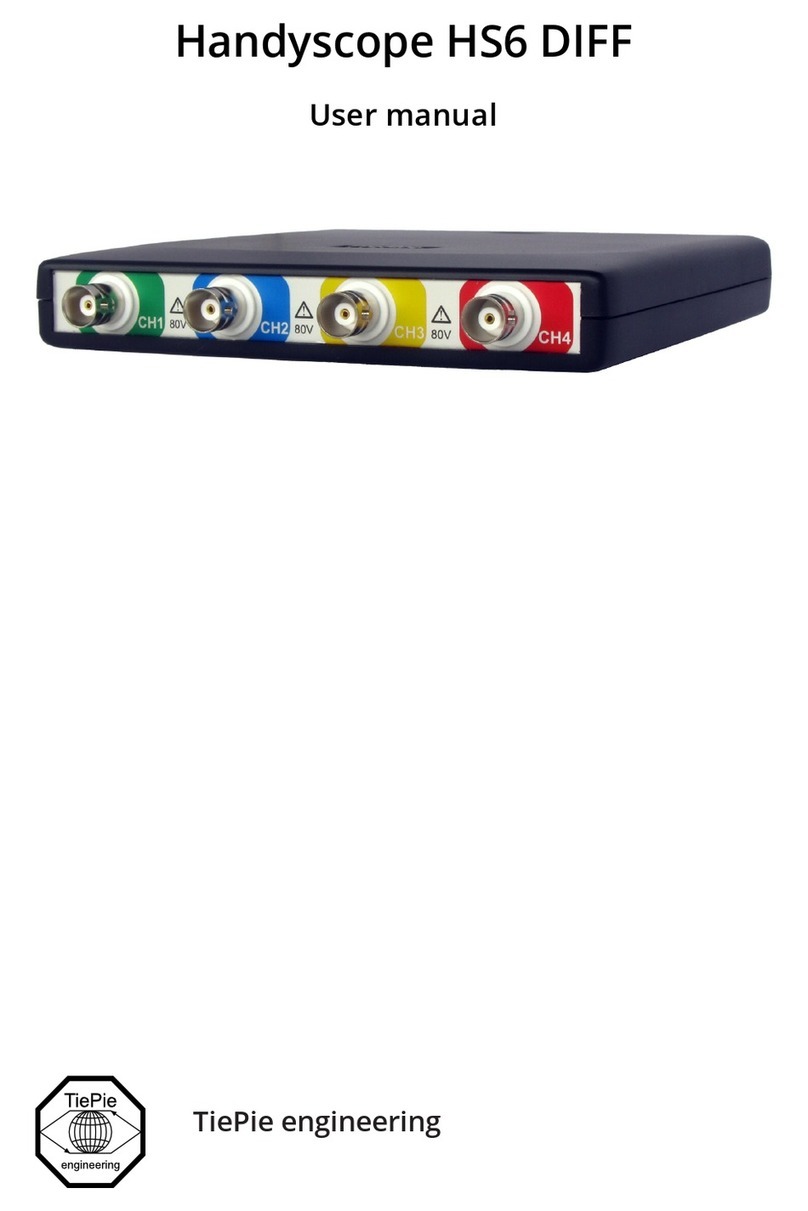
TiePie
TiePie Handyscope HS6 DIFF Series user manual
